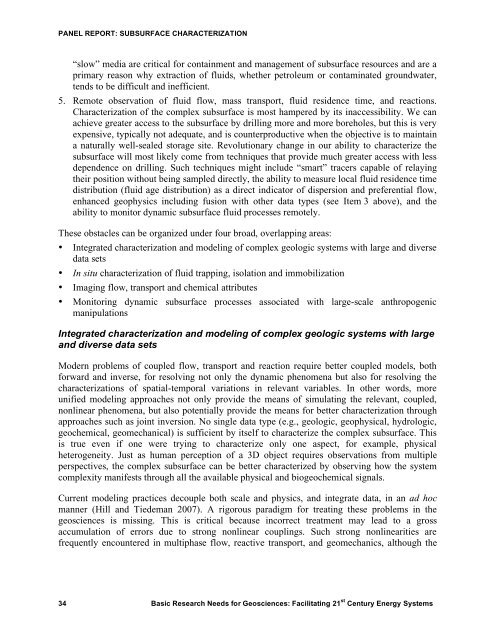Basic Research Needs for Geosciences - Energetics Meetings and ...
Basic Research Needs for Geosciences - Energetics Meetings and ...
Basic Research Needs for Geosciences - Energetics Meetings and ...
- No tags were found...
You also want an ePaper? Increase the reach of your titles
YUMPU automatically turns print PDFs into web optimized ePapers that Google loves.
PANEL REPORT: SUBSURFACE CHARACTERIZATION“slow” media are critical <strong>for</strong> containment <strong>and</strong> management of subsurface resources <strong>and</strong> are aprimary reason why extraction of fluids, whether petroleum or contaminated groundwater,tends to be difficult <strong>and</strong> inefficient.5. Remote observation of fluid flow, mass transport, fluid residence time, <strong>and</strong> reactions.Characterization of the complex subsurface is most hampered by its inaccessibility. We canachieve greater access to the subsurface by drilling more <strong>and</strong> more boreholes, but this is veryexpensive, typically not adequate, <strong>and</strong> is counterproductive when the objective is to maintaina naturally well-sealed storage site. Revolutionary change in our ability to characterize thesubsurface will most likely come from techniques that provide much greater access with lessdependence on drilling. Such techniques might include “smart” tracers capable of relayingtheir position without being sampled directly, the ability to measure local fluid residence timedistribution (fluid age distribution) as a direct indicator of dispersion <strong>and</strong> preferential flow,enhanced geophysics including fusion with other data types (see Item 3 above), <strong>and</strong> theability to monitor dynamic subsurface fluid processes remotely.These obstacles can be organized under four broad, overlapping areas:• Integrated characterization <strong>and</strong> modeling of complex geologic systems with large <strong>and</strong> diversedata sets• In situ characterization of fluid trapping, isolation <strong>and</strong> immobilization• Imaging flow, transport <strong>and</strong> chemical attributes• Monitoring dynamic subsurface processes associated with large-scale anthropogenicmanipulationsIntegrated characterization <strong>and</strong> modeling of complex geologic systems with large<strong>and</strong> diverse data setsModern problems of coupled flow, transport <strong>and</strong> reaction require better coupled models, both<strong>for</strong>ward <strong>and</strong> inverse, <strong>for</strong> resolving not only the dynamic phenomena but also <strong>for</strong> resolving thecharacterizations of spatial-temporal variations in relevant variables. In other words, moreunified modeling approaches not only provide the means of simulating the relevant, coupled,nonlinear phenomena, but also potentially provide the means <strong>for</strong> better characterization throughapproaches such as joint inversion. No single data type (e.g., geologic, geophysical, hydrologic,geochemical, geomechanical) is sufficient by itself to characterize the complex subsurface. Thisis true even if one were trying to characterize only one aspect, <strong>for</strong> example, physicalheterogeneity. Just as human perception of a 3D object requires observations from multipleperspectives, the complex subsurface can be better characterized by observing how the systemcomplexity manifests through all the available physical <strong>and</strong> biogeochemical signals.Current modeling practices decouple both scale <strong>and</strong> physics, <strong>and</strong> integrate data, in an ad hocmanner (Hill <strong>and</strong> Tiedeman 2007). A rigorous paradigm <strong>for</strong> treating these problems in thegeosciences is missing. This is critical because incorrect treatment may lead to a grossaccumulation of errors due to strong nonlinear couplings. Such strong nonlinearities arefrequently encountered in multiphase flow, reactive transport, <strong>and</strong> geomechanics, although the34 <strong>Basic</strong> <strong>Research</strong> <strong>Needs</strong> <strong>for</strong> <strong>Geosciences</strong>: Facilitating 21 st Century Energy Systems
















